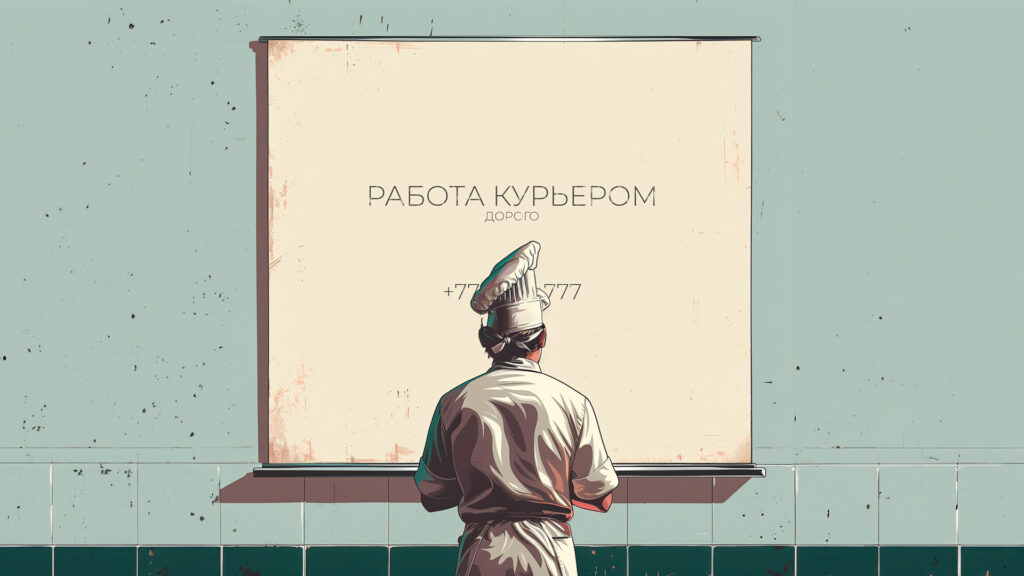Being a chef is quite popular in Kazakhstan, so why do local cafés and restaurants struggle with labor shortages?
The labor market situation in the food industry has worsened significantly over the past several years, as more and more chefs leave their occupations in favor of other fields with higher wages. Kazakhstani restaurateurs often lure employees away from one another by raising salaries. However, this does not help solve the problem of labor shortages in the market.

According to Kazakhstan’s Ministry of Education, there are 158 colleges in the country where students can be trained to become cooks. Authorities have claimed that 4,983 students graduated from these colleges this year and 87.6% (4,367) of them were hired as cooks.
However, the ministry does not track how many of these newly trained chefs remain in the occupation. Kazakhstan’s College of Hospitality and Tourism (KITIG), one of the leading educational institutions in the sector, reports that most new specialists quit the profession within the first few years.
«About 75% to 85% of our graduates (chefs, pastry chefs and technologists) are typically employed after completing their education. However, after one year, only 35% to 40% of them are still in the industry,» said Liliya Rakhimgireeva, deputy head of the college overseeing professional education, during a roundtable at the Almaty Food Fest 2024.
As she noted, being a chef requires a great deal of physical stamina to work over a hot stove for eight to twelve hours, all while overseeing a variety of processes, including food preparation.
«Many students enjoy working in the kitchen during their practicum but quickly realize how difficult this occupation is once they start working in a real kitchen. They experience burnout,» Rakhimgireeva commented on why newcomers leave the industry.
Working such demanding hours, a chef earns $37 to $47 per shift or about $625 per month (working two days on and two days off). A qualified sous chef earns $835 to $1,250 per month, depending on the tasks and the restaurant category. For head chefs, the range is even wider, from $1,250 to $3,120.
«If we’re talking about a real business that generates profit, not a ‘toy’ restaurant wasting investors’ money, it’s crucial to ensure the payroll budget is properly managed. The restaurant business is risky and low-margin. To make a profit, you need to keep labor costs at no more than 25% of your revenue,» explained Svetlana Khaninayeva, brand chef at the Kazmyaso restaurant in Platforma.
According to Artem Marchenko, founder of The Chef Group (which operates restaurants such as Zina, Kuzina and Marcello), payrolls can account for as much as 35% of a restaurant’s revenue. There are even periods when a restaurant might generate no revenue at all after covering wages and other payments.
From construction workers to cooks and back
Low salaries are one of the primary reasons for the current labor shortage. The industry saw a significant outflow of workers during the COVID pandemic when many kitchen staff switched to jobs as delivery agents. Since then, the labor market in HoReCa (hotel/restaurant/catering) has not returned to pre-pandemic levels.
«When a 20-year-old kitchen worker knows that he can earn more as a delivery man, he leaves. Unfortunately, that’s what we’ve seen post-COVID. Those who still work in kitchens are people who truly love their occupation and are passionate about it. They account for 20% of the staff, but that’s not enough to sustain a successful restaurant,» Khaninayeva said.
Staff turnover is not a new issue in the food industry, though.
«Years ago, many cooks were former teachers. There was a time when cooks earned more than teachers. Then the government raised teachers’ salaries, private schools emerged and we saw the reverse: teachers returning to their profession,» Marchenko recalled.
«Now, there’s talk of a potential crisis in the construction industry. If that happens, we’ll likely see former construction workers taking jobs as cooks,» he added. Currently, however, the trend is reversed, with cooks leaving the food industry to try their luck in other fields. Those who remain are valuable assets for headhunters.
«Labor shortages are a chronic problem in the food industry,» said Radovan Simonovich, chair of the Union of Independent Restaurateurs.
This deficit stems from many factors, some of which are positive. For example, the growing number of cafés and restaurants creates additional demand for skilled labor.
«Twenty years ago, there was stiff competition for jobs in good restaurants. For instance, when I started working in the kitchen 11 years ago, they wouldn’t hire me because I had no experience. Today, the situation is entirely different — restaurants hire almost anyone. Now, employers compete for workers, not the other way around,» Khaninayeva highlighted.
«Not every food outlet can compete successfully for staff, as labor shortages drive up salaries and create a need for better professional growth opportunities,» Simonovich added.
According to The Chef Group’s CEO, new restaurants are often the ones trying to poach cooks.
«A cook can waste thousands of dollars’ worth of products before becoming a true professional. As a company, we invest heavily in training each specialist, only to lose them when another restaurant offers a higher salary. It’s easier for a new competitor to pay more to an experienced cook than to train their own staff,» Marchenko pointed out.
To retain employees, restaurateurs invest not only in training but also in improving working conditions.
«We are constantly forced to raise salaries and offer bonuses because the number of cooks is declining, and we need to motivate them to stay. Some restaurants ask waiters to share their tips with cooks, while others offer improved employee benefits,» Khaninayeva said.
Restaurateurs have also noticed that the approach to cooks’ salaries has changed. All wages are now paid officially, unlike several years ago when payments were often made under the table.
«The rescue of a starving man is his own responsibility»
«Training staff internally or in collaboration with educational institutions is a reliable but slow solution,» Simonovich said, emphasizing the need for restaurants to nurture their own labor force.
Marchenko has a similar plan. As he told Kursiv.media, he plans to launch a culinary school. «We need this. There’s a shortage of qualified staff in the market, so we’re going to solve the problem ourselves,» he said, describing the initiative as an investment in the industry’s future.
«We are currently constructing a building for our restaurant and one of the floors will house a school with classrooms where we will train our new employees,» he added.
The school will teach culinary basics over six months to a year, with its graduates working in the company’s restaurants. While the education will be free for students, they will be required to sign a five-year contract. If a graduate chooses to work for a competitor after completing the course, they will have to pay back the cost of their training. According to Marchenko, there is no school like this in Kazakhstan. The project is expected to launch within three years.

